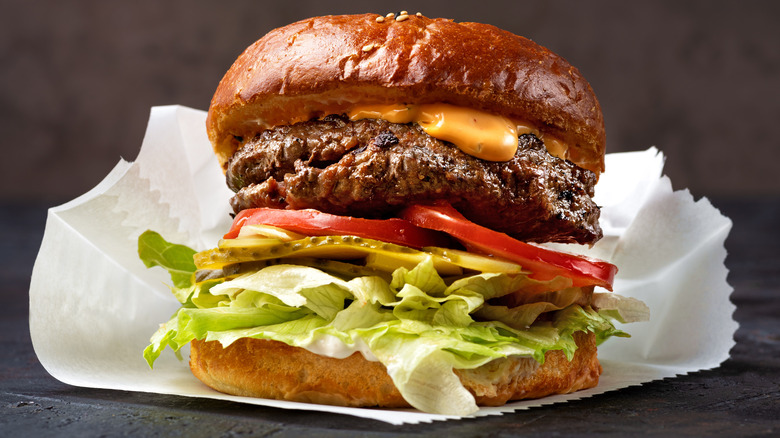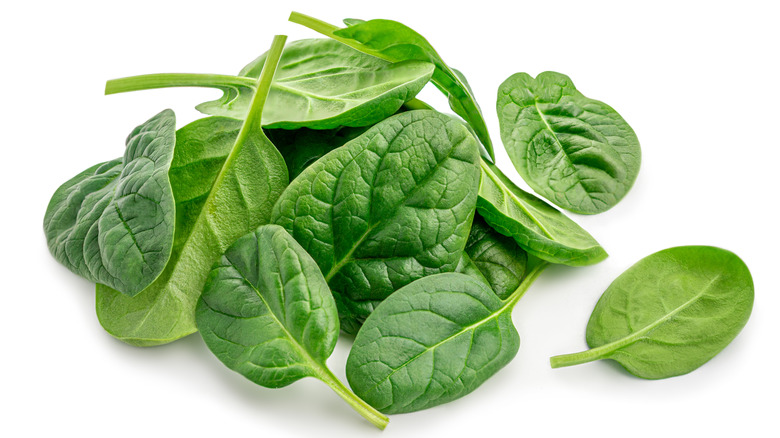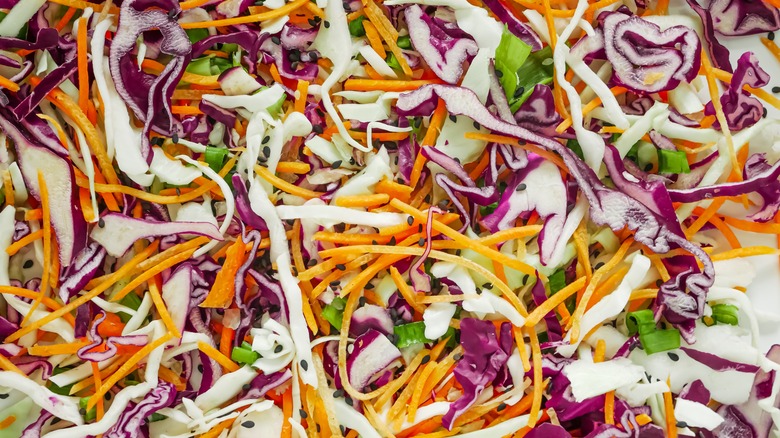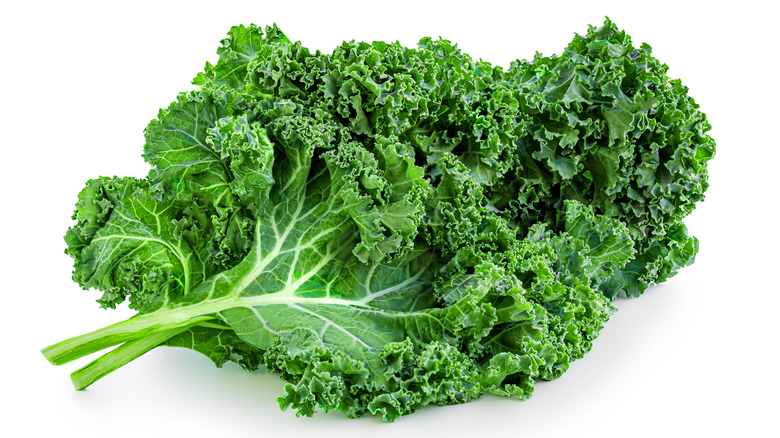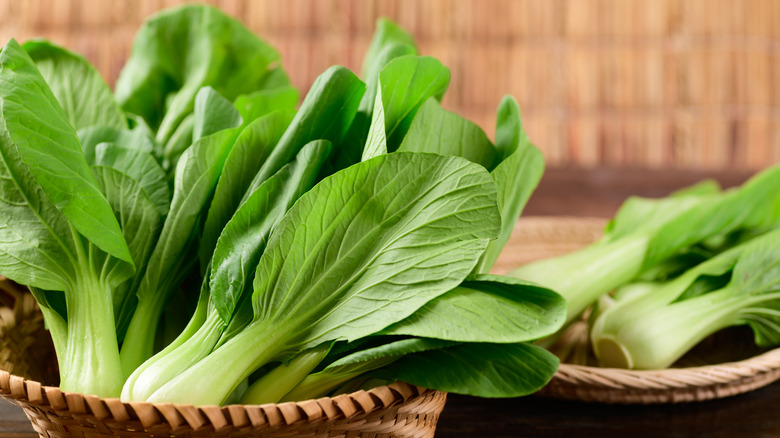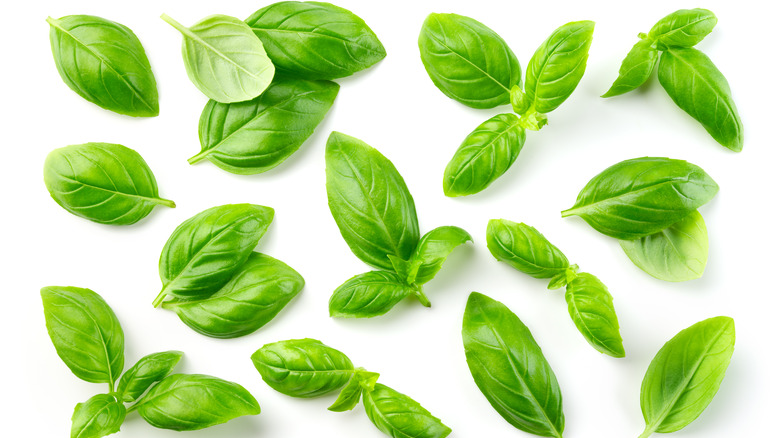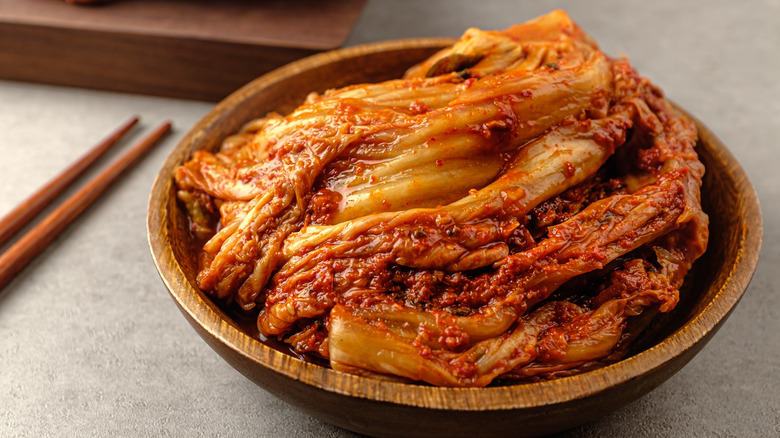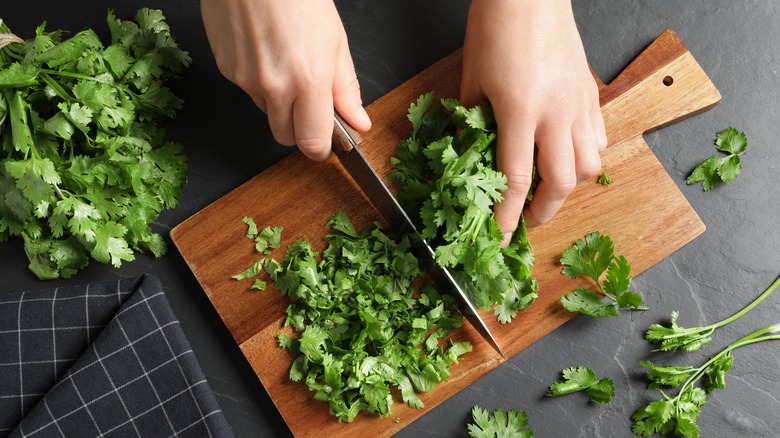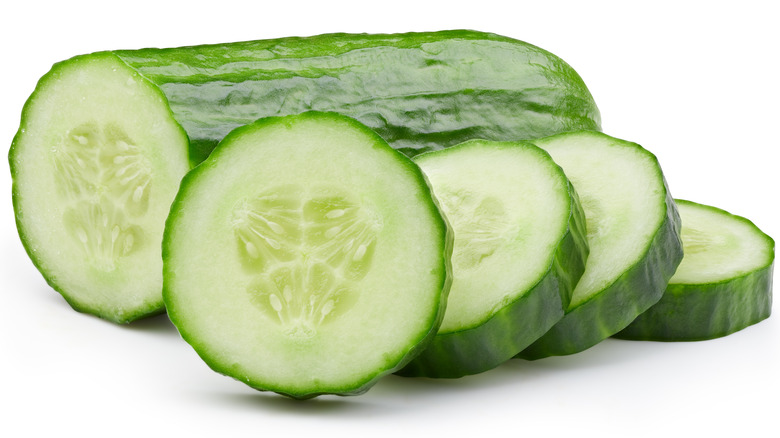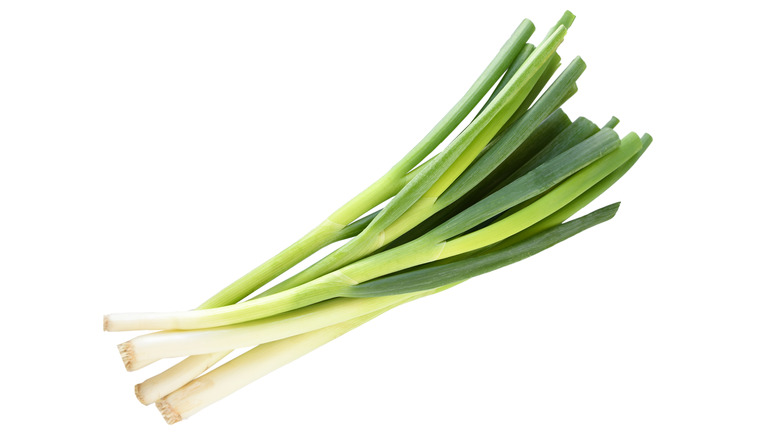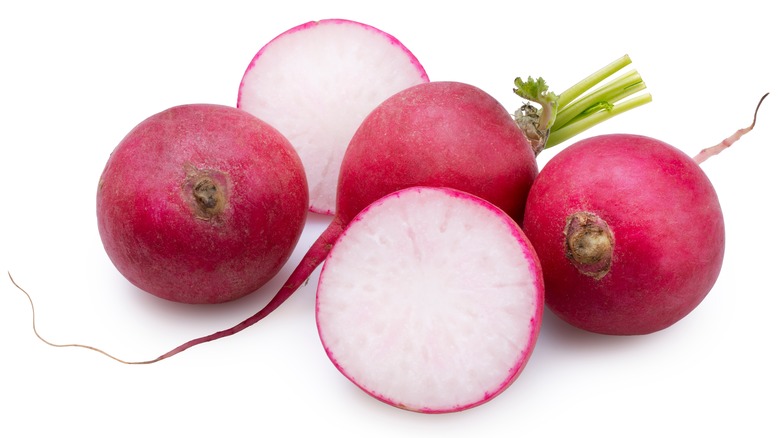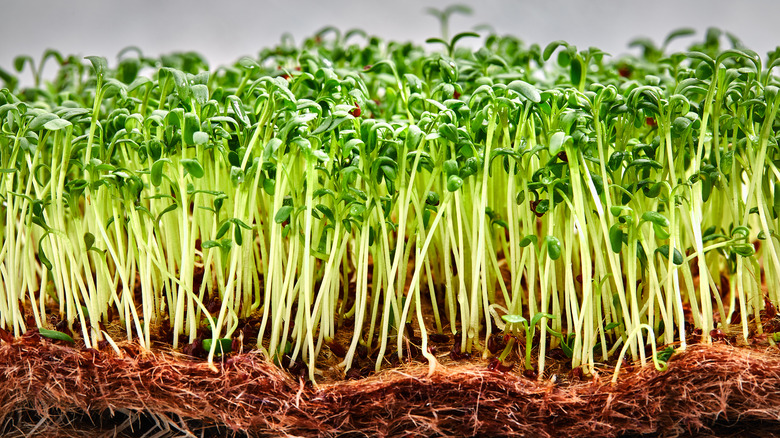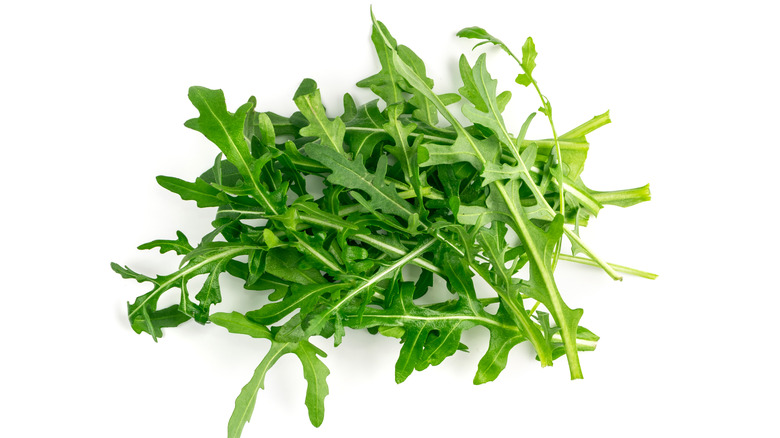12 Lettuce Alternatives That Will Shake Up Your Homemade Burgers
The beauty of a burger lies in its simplicity: With just a few humble ingredients and the right technique, anyone can whip up one that's truly delicious. All it really takes is some fresh ground chuck, a few pinches of salt, lightly toasted buns, a few toppings, and boom — you have some of the tastiest handheld fare around. At the same time, it's easy to get bored if you always stick to the same ingredients. If you're tired of lettuce, the good news is that there are plenty of other leafy options on the table to shake up your burger game a bit.
While it's true that lettuce can provide some refreshing crunch to your burger, the fact remains that it's not exactly the most flavorful ingredient in the world. Lettuce also has an extremely delicate texture and tends to wilt when exposed to heat, often resulting in a mass of watery mush. This should be expected, considering that lettuce is more than 90% water.
Of course, all vegetables soften to some degree when exposed to heat, but there's no doubt that some leafy toppings can hold up better or at least deliver more flavor than lettuce can. So if you're looking for some ways to swap out that tired old lettuce of yours for something a little different, then you've come to the right place. Read on to check out some easy lettuce substitutes that can work as tasty replacements on your burgers.
1. Spinach
Spinach is an excellent alternative to lettuce for your burger. Not only does spinach have more flavor, but it's also packed with vitamins and minerals. It's widely available, relatively easy on the wallet, and also stays good in the fridge for well over a week. When it comes to using spinach on a burger, we'd recommend going for baby spinach, since it's more tender and easier to chew. Another bonus: Because the leaves of baby spinach are so small and tender, there really isn't any preparation involved. Just pluck a few leaves and put them directly on your burger.
Regular raw spinach leaves, on the other hand, tend to be much denser and feature a firmer texture that might not be best suited for a burger. That said, you can always lightly cook your spinach a bit to soften it up a little, depending on your textural preferences. This also presents the perfect opportunity to add some extra flavor during the cooking process.
After adding a touch of butter, try stirring in some garlic paste along with a pinch of salt and pepper. Then squeeze some fresh lemon juice over the spinach right at the end of cooking and give it a thorough stir so that it can coat every leaf. The garlic will add some slight bite, while the lemon juice will add a citrusy pop of brightness. The refreshing flavor of garlic spinach with a touch of lemon will help balance out the fatty richness of your burger.
2. Coleslaw
Coleslaw is another great choice for your burger. Typically made with thinly shredded veggies like cabbage and carrots, coleslaw provides a much better crunch than lettuce. Cabbage also comes packed with a wide range of health benefits: Eating just one cup provides over a third of your recommended daily intake of Vitamin C. But even beyond its inherent nutritional value, cabbage has a relatively neutral taste that works perfectly as a vessel to carry the other flavors in a coleslaw. And there are a ton of varieties you can try out to complement your burger.
If you want that classic coleslaw flavor, all you really need is some mayo, lemon juice, and Dijon seasoned to taste with salt, pepper, garlic, and sugar. For a more acidic bite, add some apple cider vinegar. If you want it to be less creamy and more citrusy, you can also just add your seasonings and simply add some lemon juice.
For a smokier kick of heat, try mixing up your coleslaw with some chipotle mayo. The chipotle peppers add a lovely layer of spicy complexity that's mellowed by the creaminess of the mayo. There's no need to settle for lettuce when you can enjoy the vibrant taste of a creamy chipotle coleslaw that pairs perfectly with a freshly grilled burger.
3. Kale
Putting kale on your burger might require a bit of preparation, but we promise that it's totally worth it. There are many different types of kale, and there are a number of ways that you can enjoy kale on your burger. You could always give it a rinse, rip the leaves off from the stems, and eat it raw. But, much like baby spinach, baby kale tends to be softer and easier to chew. When kale is bigger and more mature and robust, you'll often find that it has a tougher texture that might require some light steaming or sautéing in order to make it more palatable.
Taking the time to cut your kale into thin strips will also make it easier to cook and eat. Once again, this is just another chance to infuse some flavor. If your kale is on the thicker side, try lightly cooking it in some olive oil with garlic, salt, pepper, and lemon juice. Just be sure to remove the stems — often called "ribs" — since they tend to be exceptionally fibrous and difficult to chew. For a little kick, try adding a shake of crushed red pepper flakes to the pan.
Once your kale is ready, simply add a few spoonfuls to the top of your burger. If you really want to knock it out of the park, add a couple strips of crispy bacon. The combination of grilled beef, tender kale, and smoky bacon strips is a truly mouthwatering experience.
4. Bok choy
When eaten raw, bok choy has a nice crunch and tastes like something between celery and cabbage. While bok choy is typically used in various styles of Asian cuisine like stir-fries, it can still serve as a great stand-in for lettuce on a classic burger. Aside from being tasty, eating bok choy also rewards the body with plenty of antioxidants and a multitude of other health benefits, according to WebMD.
You can approach adding bok choy to your burgers in a few ways. If you want it to maintain its crunchy texture, then it's best to just leave it raw. Bok choy has a round, white bulb at its base that looks like a celery stalk. Leaving that whole bulb on your burger might be a bit structurally awkward, so we'd recommend cutting that piece off (and maybe popping it in your mouth for a quick snack). Then you can just use the green leaves of the bok choy for your burger.
Another option would be to sauté the bok choy until it's a little more tender. Going this route will soften the bok choy, so you will lose some crunch — but it also presents a chance to customize the flavor. Try sautéing it in some avocado oil until it softens and then deglaze with a mix of soy sauce, garlic, honey, and ginger. Keep cooking until the sauce has thickened and thoroughly glazed the bok choy. Why use a slice of plain lettuce on your burger when you can have some deeply flavorful, garlicky bok choy instead?
5. Basil
With a taste that's slightly sweet yet almost peppery and even minty, fresh basil has a uniquely delicious flavor and pleasantly pungent aroma. While fresh basil tends to be paired with Italian dishes like marinara sauce or Margherita pizzas, it can still function surprisingly well in other contexts, too — like on a freshly grilled burger.
The beauty of basil is that it doesn't really require much effort or preparation to enjoy. Simply pluck a few leaves, place them on top of your burger, and voila — you have some tasty greenery to pair with your beef. Because basil has such a distinctive taste that we tend to associate with Italian food, this is a great opportunity to put a little Italian spin on your burger. To complement the basil, try topping your burger with some slices of fresh mozzarella and fresh slices of juicy tomato. While this classic trio is typically relegated to the realm of a Caprese salad, it can also really amp up the taste of a grilled burger.
If you really want to go the extra mile, you could even lightly toast your buns with some garlic butter. The combination of fresh basil, garlic-toasted buns, fresh mozzarella, and sliced tomatoes is a refreshing Italian twist on a classic burger that will have you coming back for more and leaving lettuce in the rearview.
6. Kimchi
This one might seem like a curveball, but the truth is that kimchi's wildly tasty flavor profile works wonders in plenty of dishes outside of fried rice. For those unaware, kimchi is basically just fermented cabbage leaves rubbed in fresh garlic and Korean red pepper flakes. Think of it like garlicky sauerkraut, but with a hint of heat — though the spiciness of kimchi can greatly vary from batch to batch. Some kimchi can be very mild while others are more fiery, so it's important to seek out a brand with a level of heat that matches your personal spice preferences.
Even though kimchi is fermented, the cabbage leaves usually still contain some level of crunch, which makes it a good textural replacement for lettuce. That said, some batches of kimchi contain bigger cabbage leaves, while others feature smaller, bite-sized pieces. When it comes to a topping for your burger, we'd recommend going for a brand that offers smaller pieces so that it's easier to chew. If you happen to buy a jar with bigger pieces of cabbage, you can always chop it up a bit before putting it on your burger.
If you want to ease your way into the world of kimchi, here's another idea: Try dicing some up and mixing it into a batch of classic coleslaw. You'll still get a hint of kimchi, and it might be easier on your palate to start off slow. One thing's for sure: The garlicky, acidic bite of kimchi pairs perfectly with grilled beef.
7. Cilantro
When it comes to greens, cilantro might take the crown for having the most refreshing flavor. Incredibly bright and almost citrusy, even just a few sprigs of cilantro can add an impressive pop of invigorating herbaceousness to just about anything it touches. While it's true that cilantro might be lacking when it comes to texture (since it's so soft and delicate), it more than makes up for it with its amazingly delicious taste. And even when it comes to the leaves' lack of texture, there's still an easy way that you can capture some crunch.
By chopping up the stems too, you can add some much-needed crispiness to mix. In fact, the stems also contain plenty of delicious flavor, so you'll get the added bonus of even more tastiness along with some extra crunch. Using some cilantro also presents an opportunity to put a tasty Mexican twist on your burger. Along with your cilantro, try adding some fresh guacamole and a spoonful of fresh salsa to your burger. If you go down this route, just be sure to add a healthy bundle of the fresh cilantro so that you can really taste it.
8. Cucumber
Cucumbers tend to be on burgers in the form of salty pickle slices, but there's no reason you can't just enjoy them fresh and raw as well. When cucumbers are left raw, they have a crisp exterior and a more delicate interior that contains a delightfully refreshing flavor. The inherent crunchiness of lettuce can easily be replicated through the use of sliced cucumbers, but there's an important step here to keep in mind.
You want to make sure to create cucumber slices with the right amount of thickness. If you cut them too thick, you'll end up with slices that add an amount of crunchiness that's overkill for the burger. On the other hand, if you slice them too thin, you'll barely be able to register their presence. The sweet spot is somewhere right in the middle: thick enough to add some crispiness, but also thin enough to take a backseat to the star of the show — the burger.
Cucumbers are also a great ingredient that you can add to other burger toppings. Try slicing them into matchsticks and adding them to coleslaw or dicing them up and mixing them into guacamole. Of course, you can also try your hand at turning them into quick homemade pickles with some salt, sugar, fresh dill, and vinegar. If you don't let them pickle for very long and use them right away, the cucumber slices will still maintain that level of crunch you're looking for to replace the lettuce.
9. Green onions
Green onions are a highly versatile vegetable. Whether you sprinkle them over a loaded baked potato or add them to a stir-fry, they're a great way to add a quick punch of taste with a subtle crunch. What's remarkable about green onions is how the flavor evolves throughout the whole vegetable. The dark green leaves have a more mellow taste, while the lighter-colored stalks have a more oniony flavor that's reminiscent of a mild garlic. Much like lettuce, the stalks of green onions have a refreshing taste that's pleasantly crunchy. But the truth is that green onions contain way more flavor than lettuce — and in our book, that makes them even more desirable.
To truly experience green onions in all their crispy glory on your burger, it's best to keep them raw. Just be sure to give them a nice dice so that they're in smaller pieces. Otherwise, if left too long, you'll be awkwardly pulling out lengthy strands of green onions from your burger with each bite. If you want the onion flavor to be a bit more mellow, all you need to do is lightly sauté them with some butter. Another option would be to soak your green onions in some ice water. Doing so will mellow out their flavor in a noticeable way so that they have a little less bite.
10. Radish
Typically used in everything from fresh salads to healthy grain bowls, radishes are crispy with a slight bite. They have a spectrum of spiciness that ranges from very mild to almost spicy (similar to raw garlic). In the context of a serving as a lettuce replacement in a burger, we'd recommend leaving radishes raw to maximize their fresh taste and texture.
Once again, the trick here is to correctly slice them. This job is perfect for a mandoline slicer — which is a device with a long, sharp blade for cutting that folds flat. Try to cut the radish so that it's not too thick. If you don't have a mandoline slicer, you can always just dice your radish into thin matchsticks.
Once your radish is cut into smaller pieces, simply place them on top of your burger. Just don't overdo it: A little goes a long way with radishes, since they have such a pungent flavor. If you want to cut back on the sharp taste of your radishes, you can simply roast them in the oven. Slice them up, rub them in some olive oil, and lightly season with salt and pepper. Once they start to brown and get crispy, pull them out of the oven. This method will essentially produce radish chips that can add a lovely level of crunch to your burger.
11. Microgreens
"Microgreens" is an umbrella term that refers to small, young greens that can be grown from a variety of different vegetable seeds. Microgreens can be grown from everything from cauliflower and broccoli to onions and watercress. They are very similar to alfalfa sprouts and have a gentle, delicate structure. Although microgreens have a wide range of flavors depending on the type of vegetable seed they've sprouted from, they tend to have a fairly robust taste.
Preparing microgreens for your burger couldn't be easier. Just be sure to give them a good rinse and then place them on top of your burger. Because they are so small and fragile, they shouldn't really require much cutting. Microgreens also happen to be highly nutritious, often containing high doses of iron, magnesium, and zinc. They can also be grown at home with relative ease, and some even come with a special single-use mat to aid in the growing process. Considering that microgreens are so healthy, tasty, and easy to grow, they are a great addition for your burgers, sandwiches, and salads. Hop on the microgreen train and see what you've been missing out on. When you do, you'll wonder why you ever settled for lettuce.
12. Arugula
Arugula is a fairly common topping for burgers at restaurants, but it's easy to forget about it when you're locked into auto-pilot mode while shopping for homemade burger ingredients at a grocery store. So we're here to give you a gentle reminder that arugula is a wise choice if you're looking to ditch the lettuce for something a little different. Arugula has a crunchy texture and a peppery flavor that perfectly complements the chargrilled beef of a burger.
Arugula is another vegetable that doesn't really require much of your time or attention, preparation-wise. Simply place a few sprigs on top of your burger and call it day. If you want to soften up the texture a bit and infuse some extra flavor into your arugula, try gently wilting it in a pan with some olive oil and fresh garlic. When the garlic starts to turn yellow and become fragrant, deglaze the pan with a splash of balsamic vinegar and turn off the heat. The garlic and balsamic vinegar will soak into the arugula, adding a pop of richness to the leafy greens that will make your burger even more mouthwatering.
